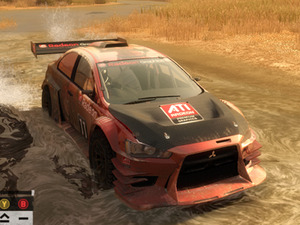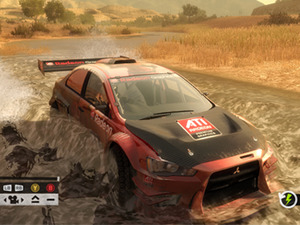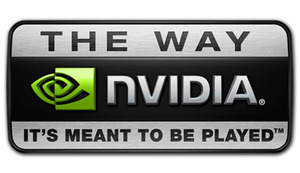Interview with Richard Huddy, AMD Developer Relations
We sat sat down with AMD’s Worldwide Developer Relations manager, Richard Huddy, to discuss all things developer, DirectX 11, Eyefinity, and his opinions on the competition: Nvidia, Fermi, GeForce 3D and PhysX and Intel’s recent progress with Larrabee.Richard started working with 3DLabs in 1996, and from 1998 to 2002 he ran Nvidia's game developer relations program and as the first non-US member of staff he set up its European office. In 2002 he joined ATI as a contractor and now works full time as its Developer Relations Manager.
The interview was recorded and transcribed. The italicised emphasis is included in the article to directly represent Richard's vocal emphasis; edits were made for clarity of meaning, syntax and brevity.
bit-tech: How exactly does AMD work with game developers? Nvidia is very vocal about its machine [The Way It's Meant to Be Played program], but we've heard less on the AMD front - why is this?
RH: Well the reason why you hear less on the AMD front is not because we do less, but we don't market our developer relations in the same way that Nvidia do. I remember an issue I raised at Nvidia in 2002 [when he worked there] and the HR manager came back to me and said, "you really don't want to raise that point - it won't do your career any good, Dan Vivoli, the VP of marketing is someone Jen-Hsun Huang is leaning on more and more these days, so if he doesn't like it, you won't make any progress on the matter." [Nvidia]'s a marketing lead company and that's not how it is with AMD. Look at our CEO at the moment: we've got Dirk Meyer, an engineer by trade who’s deeply a technologist.
I mean, I've still got a respect for Jen-Hsun because he knows his tech too, but Nvidia is clearly a marketing lead company. [Nvidia] has put this big program together with equally big label that they shove in your face all the time, but I don't really think what they do is radically different than what we do - we just don't make as much noise about it.
How do we work with people? Well looking at the process we did with DirectX 11, we seed samples and early drivers [to developers]. We have excellent relationships with a number of key games developers which means we give them pre-release drivers, sometimes several times a day if it's on a key issue, but that's rare. Along with seeding the hardware we'll put engineers on site - so if you look at Dirt 2, STALKER: Call of Pripyat and Unigen have their engine out there at the moment, these are the only DirectX 11 titles right now -


Two images contrasting Dirt 2 in DX9 mode (left) and DX11 mode (right)
bit-tech: -from the ground up you mean?
RH: Absolutely. BattleForge, STALKER, and with Dirt 2 have had engineering visits [from us] and engineering on site and they have access to engineering communication on the phone or email. Along with that we have a co-marketing program, so BattleForge - there was a DirectX 10.1 version out in March - we had a co-marketing program with them and we pushed it as "this is DirectX 10.1, look at what it can do for you and the performance advantages you can get by running 10.1 over 10." We do this by bundling games as well, I think we bundled BattleForge - we've certainly bundled STALKER and we're bundling the hell out of Dirt 2 right now. The engineers and CTO from Codemasters put together a video for us to talk about the co-operation we've done with them.
We'll promote those bundles to our AIB partners and OEMs as well where it's relevant. We're working with Rebellion on a future title - that's a pretty blood thirsty title (Aliens versus Predator]) so I wouldn't expect someone like Dell to include it - when you're ripping people's spines out and keeping their skulls, it's not kind of the message you want to send with PCs. Something like Dirt 2 is a cool racing game that is acceptable worldwide, so we push that through the channel ecosystem.
 bit-tech: How do you decide who to work with, or is it simply a case of they come to you if games developers want to add the extra features such as DirectX 11?
bit-tech: How do you decide who to work with, or is it simply a case of they come to you if games developers want to add the extra features such as DirectX 11?RH: A few of the games developers came to us asking about DirectX 11 because Microsoft obviously were out there pushing the message as well, but the key point for DirectX 11 adoption was actually GDC, March 2009, that's when we had a number of games developers approach us that were not at that point on our radar. We were already looking around and were in cooperation with Codemasters, and Rebellion came to us in March as well, plus we were already working with EA for BattleForge and GSC Gameworld for STALKER on DirectX 10.1 it was a natural extension there. We certainly want people to come to us if they haven't already been approached by us - anyone who is good at taking on technology and can accept the transition from DirectX 9 to 11 or 10-10.1 to 11, then they are a natural candidate for us to talk to.
We need acceptability of the game if we want to bundle it - we want games that are going to be played and used by you guys. It's very interesting for us that we work closely with games that are going to be used for reviews, clearly we cannot afford to ignore them.
There isn't anyone we won't work with - we certainly don't stand back and say "that's a 'Way It's Meant To Be Played' title, let's not work with them", in fact, quite the opposite. We make sure everyone who gets early builds of their software gets a chance to work with us and we have extensive testing labs so even if we're not doing all the rest of the big program stuff we can just do testing - things such as Batman: Arkham Asylum, which we have an engineer assigned to and we got builds in regularly. If we see something that alarms us then we go after it and try and fix it.
bit-tech: How is AMD's support for Dirt 2 - where you give a lot of marketing, engineering support and bundling, different from Nvidia's support to Rocksteady with Batman? Nvidia is injecting its own IP into the game - in terms of PhysX, and the game's anti-aliasing method - and then protecting its own business interests, as both are Nvidia-only.
RH: The Rocksteady stuff is interesting from a number of perspectives. For starters, it's a DirectX 9 title so it doesn't push hardware terribly hard, and it certainly doesn't push any of the new capabilities. I won't deny it's a perfectly good game but in terms of using new hardware and using it hard - it doesn't - so it's not insanely exciting to us. However, I have one of my best engineers - one of my most pro-active engineers - and he was getting builds on a regular basis. We did talk to Eidos about the possibility of being a co-marketed title with us, however Nvidia decided it would - to use your phrase - inject its IP into it. It did this in two parts, one of which I've got I've got a reasonable amount of respect for and the other I frankly hold in complete contempt.
[Nvidia] put PhsyX in there, and that's the one I've got a reasonable amount of respect for. Even though I don't think PhysX - a proprietary standard - is the right way to go, despite Nvidia touting it as an "open standard" and how it would be "more than happy to license it to AMD", but [Nvidia] won't. It's just not true! You know the way it is, it's simply something [Nvidia] would not do and they can publically say that as often as it likes and know that it won't, because we've actually had quiet conversations with them and they've made it abundantly clear that we can go whistle.
However, PhysX is a piece of technology that changes the gameplay experience and maybe it improves it. What I understand is that they actually invested quite a lot, Nvidia put in a hefty engineering time and they tried to make a difference to the game. So, in that aspect, I have respect for it; it's a reasonable way to handle the situation given the investment in PhysX. Nvidia wanted a co-marketing deal and put forward PhysX, and Rocksteady and Eidos said, OK, as long as you do it - which they did.
The part that I totally hold in contempt is the appalling way they added MSAA support that uses standard DirectX calls - absolutely nothing which is proprietary in any useful sense. They just did ordinary stuff, a completely standard recommendation that they make and that we make to developers for how to do MSAA, and they put it in and locked it to their hardware knowing it would run just fine on our hardware. And indeed, if you simply spoof the vendor ID in the driver - which we and other people have documented - it runs absolutely fine on AMD hardware. There's nothing proprietary about it in that sense, nothing new. I think that's exceptionally poor.
What I could have done as the Developer Relations guy at AMD is say "actually, what they're doing is a reasonable business investment and I'll do exactly the same thing for all the DirectX 11 code we are adding. We'll just go in an add it, and since I can't QA it on Fermi because all they've got still is a faked up board that they showed off recently, what I'll do is I'll lock it to our hardware." Morally I think that would be reprehensible, but from a business point of view I could argue in favour of it, but we think it's really the wrong thing to do and we've not locked a single line of DirectX 11 code. That's the difference in the way [AMD] works - we work through enablement and open standards. [Nvidia] works through closed standards and disablement, which, to me is inexcusable; it's as bad as that.

MSI MPG Velox 100R Chassis Review
October 14 2021 | 15:04









Want to comment? Please log in.